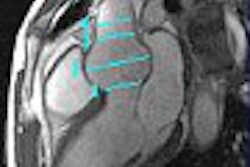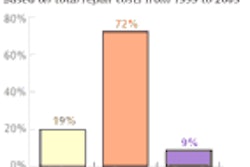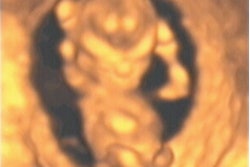ATLANTIC CITY, NJ - Duplex lower venous ultrasound exams face a number of limitations, including operator dependency and the nature of ultrasound physics, according to a presentation Wednesday at the Leading Edge in Diagnostic Ultrasound conference.
"The realization and knowledge of the pitfalls of the duplex lower venous examination, (as well as) potential solutions, will aid in the accuracy of interpretation for better patient care," said Dr. Mark Oliver of Morristown, NJ.
Other serious limitations of the exams include anatomic variation and extravascular structures; potential imitations include possible difficulties encountered with color, clot aging, and recurrent deep venous thrombosis (DVT) evaluation, said Oliver, who's also a registered vascular technologist (RVT).
Operator dependency
Of course, duplex scanning is essentially a two-part study encompassing real-time and Doppler scanning. As a result, operators must be able to recognize normal and abnormal venous Doppler signals, as well as normal and abnormal B-mode findings, Oliver said.
"The technologist that's doing the study is the key player here," he said.
Technologists must gain a thorough understanding of concepts such as venous anatomy, pathogenesis, pathophysiology, and mechanisms; beginners can save time in the learning process by working hands-on with an experienced examiner, Oliver noted.
"That can be very helpful to override the pitfalls you may have on the examination," he said.
While imaging of the femoral popliteal vein may only take a month or so to master, the calf-vein exam is much more demanding and will likely take more than six months to become proficient, Oliver noted. Proper patient positioning is very important to ensure an adequate study; examiners must know their landmarks, he said.
It's also critical to know exactly why the study is being performed, whether to rule out DVT or venous insufficiency (VI) or both. Vascular labs should establish a standard protocol that's repeatable and reproducible with good quality assurance, he said.
"I believe very strongly that accreditation is important because it forces you to do QA," he said.
Ultrasound limitations
Factors such as obesity, severe edema, and gas can interfere with ultrasound exams and produce a suboptimal, non-interpretive study, Oliver said. While these factors are beyond an operator's control, users do have some weapons at their disposal, including swapping in a transducer with a different frequency and changing focal zones, gain settings, or color Doppler settings and modality (i.e. color power).
A position change can also help eliminate problems with gas and bone, Oliver said. Proper patient preparation (such as having patients take anti-gas medication before abdominal exams, for example) is also beneficial.
Bone can also be used to the operator's advantage as a landmark, a particular benefit in calf-vein imaging, Oliver said. Even when the image is suboptimal, Doppler scanning can be used to confirm venous patency, he noted.
Handling anatomic variation, extravascular/intravascular structures
Operators will also come across duplicated vein systems, which are seen in the greater saphenous, superficial femoral, and popliteal veins, Oliver said. Knowledge of this problem, and a careful exam, is the best solution for this, he said.
The gastrocnemius vein may be mistaken for the lesser saphenous or popliteal veins in the popliteal fossa and upper calf, he said. B-mode and venous Doppler interpretation can be affected by compression of venous structures by extravascular structures (such as tumors, pelvic structures, or pregnancy).
Extravascular structures (such as lymph nodes, Baker cysts, hematomas, abscesses, nerves, bowels, and edema) and non-thrombotic intravascular structures (such as venous catheters, valves, and tumors) can also be potential sources of diagnostic error, Oliver noted.
"The experience of knowing the B-mode imaging characteristics, having a good knowledge and foundation of the anatomic landmarks, that's going to help you get through these problems," he said.
Color, clot aging, and recurrent DVT
Although color Doppler can certainly enhance a duplex exam, it can also be a potential pitfall with improper use, Oliver said. A color image may obscure a non-occlusive clot with too much color gain, and a clot may be misdiagnosed if color is not visible because of improper gain or Doppler angle.
"You have to be very careful when you use color," he said
While the diagnosis of very acute thrombosis versus old thrombosis is relatively easy, it can be challenging to estimate clot aging between the two extremes, Oliver said. Clinical correlation and other guidelines should be considered.
The possibility of recurrent DVT is another potential problem area, because of possible anatomic distortion, collaterals, and residual clots that can't be readily identified as new clots, he said. Measuring clot diameter may be useful in the aid of DVT therapy.
"Although we have pitfalls (in duplex lower venous examinations), we have to learn how to make the best of it and take advantage of the (potential solutions) to solve these problems."
By Erik L. RidleyAuntMinnie.com staff writer
May 13, 2004
Related Reading
Emergency ultrasound training improves, but few ER docs meet AIUM guidelines, March 29, 2004
MDCT pulmonary angiogram rules out PE for months, March 22, 2004
Combined test strategy safely detects pulmonary embolism in outpatients, March 11, 2004
Controversy flows freely in venous ultrasound, August 28, 2003
US can confirm if surgery is right for popliteal artery aneurysm, August 5, 2003
Copyright © 2004 AuntMinnie.com




















